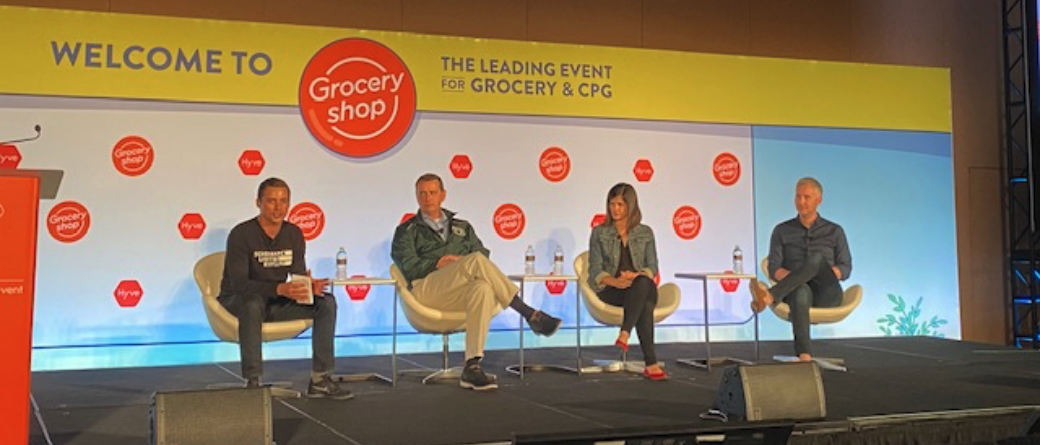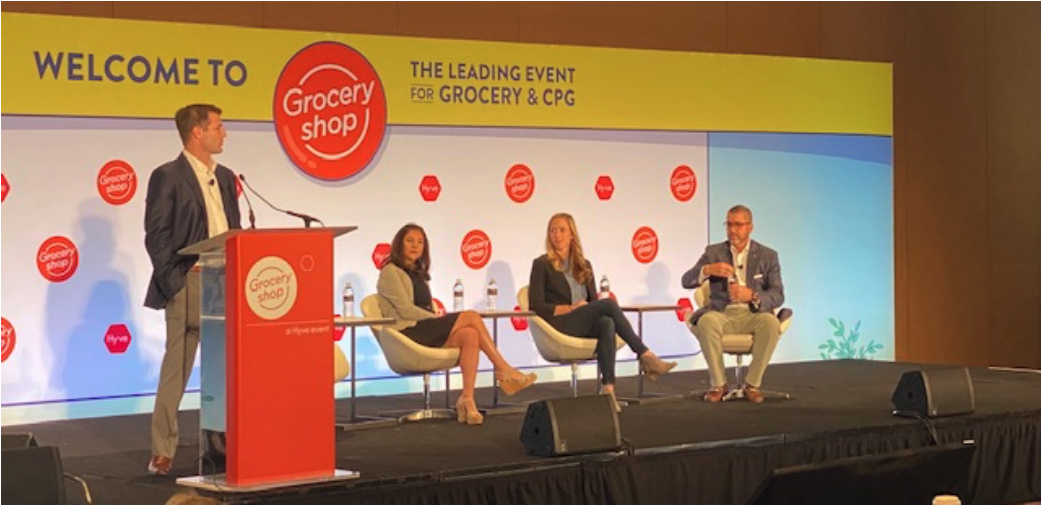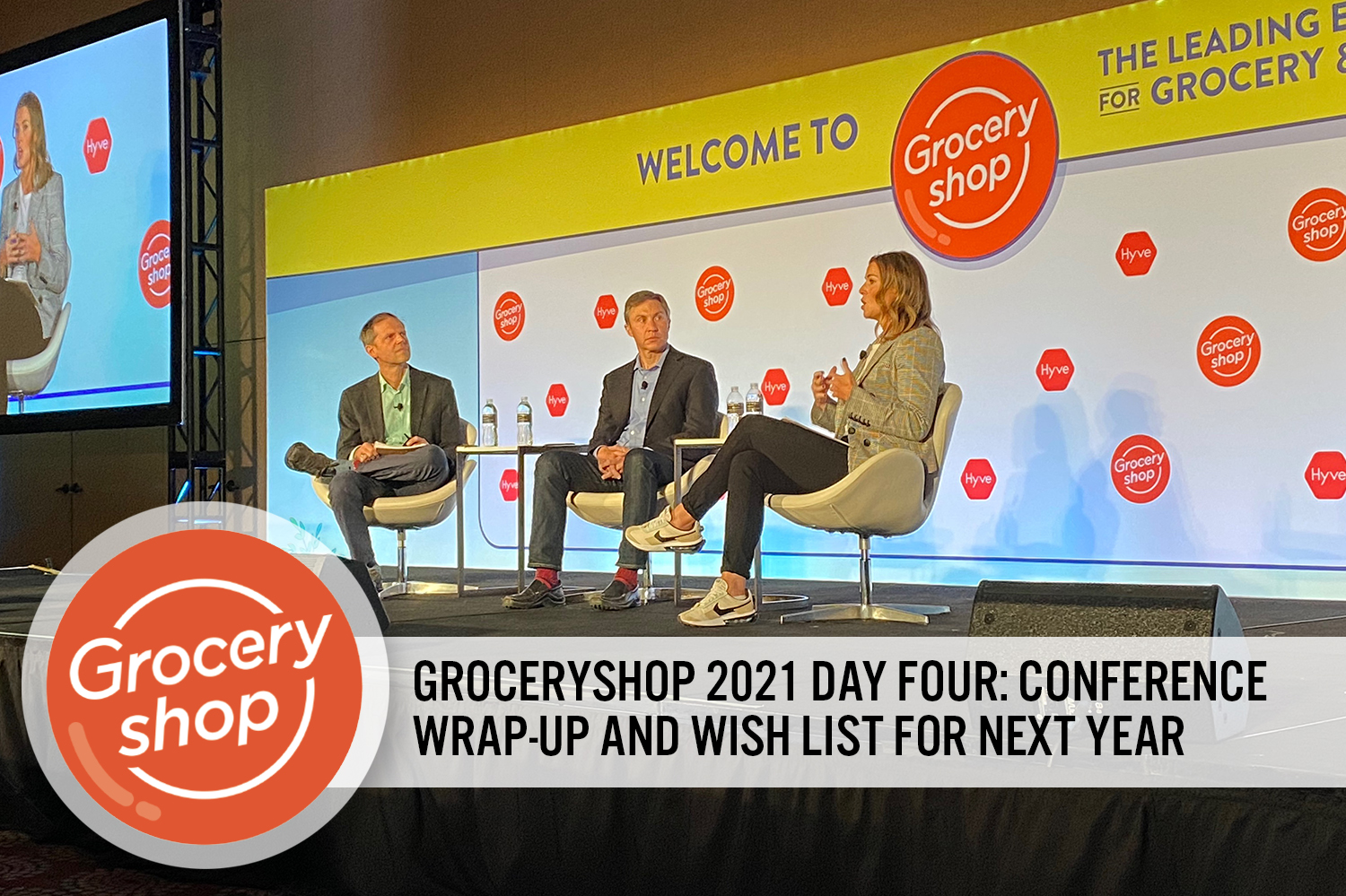What’s the Story?
The Coresight Research team was in Las Vegas this week participating in the Groceryshop 2021 conference, which was held from September 19 to 22. Featuring more than 150 CEOs and over 200 speakers, the event focused on recent transformation in the retail environment, and technology and innovation in consumer packaged goods (CPG), food and grocery.
In this report, we note key insights from the retail and technology sessions on the fourth and final day of the event, with highlights of the main themes that have emerged through the conference—namely, convenience, retail media networks, everywhere retail, speed (and profitability), purpose, experiences, transparency and CPG-retailer relationships.
Groceryshop 2021 Day Four: Key Insights
Robotics, Automation and Other Grocery Fulfillment Models
- Speakers: Bridget Fruit, Chief Operating Officer at Shipt; R Benjamin Thompson, Head of Digital Transformation at Endeavour Drinks Group (a unit of Woolworths Group); Ali Ahmed, Co-Founder and CEO of Robomart; L Jason Goldberg, Chief Commerce Strategy Officer at Publicis Groupe (Interviewer)
This session featured companies taking a variety of approaches to fulfillment.
According to Thompson, due to Australia’s isolated nature and high level of economic development, the country serves as an excellent test bed for new retail concepts for
Woolworths Group. He said that Australia’s large retail market consists of six micro-economies, and retail prices are highly competitive and volatile, changing frequently.
Shipt gave a presentation focused on the human connection between the delivery agent and the consumer. When a consumer rates a deliverer with five stars, they can designate that delivery agent their “Preferred Shopper,” cementing the relationship.
In contrast to the emerging horde of retailers offering 15–20-minute delivery services,
Robomart offers “two-minute” delivery: It takes two minutes to complete a purchase once the company van arrives at the customer’s house. At Groceryshop, Robomart announced that its platform for retail, offering vans for grocery, snacks, pharmacy, ice cream and fast food, to be available in early 2022. The company also announced that REEF, the largest operator of mobility and logistics hubs and neighborhood kitchens in the US, was the first merchant on its platform.
Building Better Click-and-Collect, Curbside and Delivery Offerings
- Speakers: Julian Counihan, General Partner at Schematic Ventures (Moderator); Barnaby Montgomery, Co-Founder and CEO of Yummy.com; Sarah Mastrorocco, VP and GM at Instacart Pickup, Instacart; Taylor Bloom, Co-Founder and CTO of Foxtrot
This session discussed how retailers are investing in pickup services, and how such offerings coexists with delivery.
There are several fundamental differences between pickup and delivery customers, according to the panelists.
- The average order size for delivery is around $47–$50 and includes heavier items than pickup orders, which have an average order size of $25.
- The timeframe is a key difference: One vendor offers pickup in as little as five minutes, whereas delivery can take 90 minutes.
- Pickups generally occur at the beginning or end of the working day, whereas deliveries occur throughout the day—particularly as many people are working from home.
- Fees make delivery the more expensive option, so price-conscious consumers are more likely to choose pickup.
- Pickup customers have more control over when they take possession of the goods: They can use curbside services and leave the kids in the car, or they can enter the store to make additional purchases and enjoy experiential services such as the store café.
Beyond technology, panelists stressed the importance of layout in new stores: making the pickup area conspicuous, streamlining the pickup staging area and even designing the parking lot to enable quick entries and exits.
Challenges for retailers include data sharing and stockouts caused by supply chain issues and labor shortages.
[caption id="attachment_133099" align="aligncenter" width="700"]
 Left to right: Julian Counihan, General Partner at Schematic Ventures (Moderator); Barnaby Montgomery, Co-Founder and CEO of Yummy.com; Sarah Mastrorocco, VP and GM at Instacart Pickup, Instacart; Taylor Bloom, Co-Founder and CTO of Foxtrot.
Left to right: Julian Counihan, General Partner at Schematic Ventures (Moderator); Barnaby Montgomery, Co-Founder and CEO of Yummy.com; Sarah Mastrorocco, VP and GM at Instacart Pickup, Instacart; Taylor Bloom, Co-Founder and CTO of Foxtrot.
Source: Coresight Research[/caption]
How Grove Collaborative Is Transforming the Future of CPG
- Speakers: Stu Landesberg, Co-Founder and CEO of Grove Collaborative; Gerald Porter Jr., Consumer Reporter at Bloomberg (Interviewer)
Landesberg opened with the terrible environmental record of CPG and home products, before describing the birth of Grove’s mission as a force for good. Grove Collaborative delivers eco-friendly home essentials; it has partnered with leading natural brands and built its own private labels in an effort to change the industry’s culture, and bring about a shift from a goal of doing less bad to one of doing more good.
Founded in 2012 as a direct-to-consumer (DTC) retailer, Grove spoke directly to consumers and was able to reduce the timeframe for new product launches to 90 days, far below the industry norm of two to three years. Landesberg described the approach as “fail fast, learn and then scale.” Natural product momentum, driven in part by consumer education, has propelled Grove to its current sustainable portfolio of 400+ private-label SKUs (stock-keeping units) along with like-minded third-party brands. Grove has been certified as a B Corp since 2014.
According to Landesberg, one thing Americans agree on is the ravages of plastic use on our planet: “84% of Americans agree that we should take action on single-use plastic.” Grove aims to be 100% plastic-free by 2025.
Landesberg echoed what we heard at multiple sessions during Groceryshop 2021: Industry-wide collaboration is needed to make a difference. To that end, Grove is now in 1,900+ Target stores, reflecting how mainstream sustainability has become—from Brooklyn to neighborhoods a fraction of the size.
Grove’s online platform emphasizes consumer education and uses digital media. This allows for complex storytelling, driving real behavioral changes and sales online and in-store.
New Customer Loyalty Strategies
- Speakers: Ken Fenyo, President of Advisory and Research at Coresight Research; Amii Lang, Head of E-Commerce and Loyalty at Heinen’s Grocery Store; Mike Molitor, Head of E-Commerce and Loyalty at Bashas’; and Andrew Thomas, VP of Marketing at Chicken of the Sea
In the “New Customer Loyalty Strategies” session, a panel of three industry leaders shared their approaches to customer relationships, how they identify and cater to their most loyal consumers and the future for loyalty strategies and tactics.
In our era of disrupted customer loyalties, brands and retailers are implementing new technologies, loyalty programs and other innovative tactics to keep customers coming back.
Grocery loyalty programs have not changed much over the last five to 10 years, but they need to evolve to engage younger shoppers. Subscriptions—particularly “subscribe and save” programs—are a significant opportunity. Capturing and using data to personalize the experience is critical for both retailers and brands: Customer experience, not programs, drives loyalty.
At Heinen’s, Lang implemented a new journey-focused approach to the Tasteful Rewards Loyalty program, centered in personalization of offers, marketing emails and targeted on-site product collections and content. Heinen’s strategy is informed by data health initiatives, listening to the voice of the customer, and a “test and learn” approach—fundamental to a continuous improvement strategy.
Molitor at Bashas’ emphasized the importance of avoiding stockouts in online sales, since “digitally it is very hard to substitute for the customer,” and punctuality in fulfillment: “Nothing engenders less loyalty than waiting in parking lot or a delivery person arriving an hour late.”
Product or brand substitutions can be facilitated by knowledgeable associates and engaged customers who inform associates of their second choices. The Covid-19 pandemic and restrictions brought Heinen’s new customers who had not experienced the in-store environment. Similar to in non-grocery retail, Heinen’s found that loyalty increased when shoppers used both channels.
At Chicken of the Sea, building a product portfolio under the named brand drove increased awareness and engagement. During the pandemic-driven disruption of the last 18 months, Amazon was a strong partner for the brand; for the year to date, sales are flat at Amazon against the heightened demand of 2020. A benefit of working with Amazon is the ability to educate consumers regarding the product, brand, sustainability and health and wellness features through Amazon’s platform; the brand is meeting its retention targets.
Data makes a difference when tied back to the individual. Using data, brands and retailers can now communicate with each customer as an individual and talk to shoppers about what interests them in a personally compelling manner, according to Lang.
Navigating Dynamic CPG-Retailer Relationships
- Speakers: Brian McRoskey, Partner at Bain & Company (Interviewer); Amanda Oren, VP of Merchandising Services and Planning at Weee!; Carolyn Brown, Head of E-Commerce, US, Anheuser-Busch; Mike Pierson, Chief Customer Officer at Campbell Snacks, Campbell Soup Company
This session discussed the complex relationships between CPG companies and retailers—sometimes partners and sometimes rivals—and opportunities for cooperation and sharing data.
As mentioned in a prior session, the environment for liquor companies is more challenging, since regulations bar them from sharing data with their retailer and distributor customers. The liquor industry has taken longer to embrace online retail and still needs to develop e-commerce expertise. The same is true for other sectors, as highlighted by Oren. On the one hand, the surge in demand from the pandemic has represented the golden age of supply for liquor companies, and companies re moving faster with more flexibility and less formality,
There was much discussion on sharing data. Since it was unable to obtain customer sources, Anheuser-Busch stitched together a data platform from external sources, which it uses to inform customers and guide marketing spending, while Weee! has in-house data scientists. One of the challenges is sharing data with suppliers using common tools to avoid time-consuming ad-hoc analysis; all parties can benefit from a unified dashboard.
Many retailers focus on a growth figure—if this figure is not achieved, panelists urged retailers to take a step back and reconsider the greater goals, as earlier panels had recommended.
While retailers and CPG providers are often rivals, panelists urged retailers to share information, practice transparency and build bridges for mutual benefit.
[caption id="attachment_133102" align="aligncenter" width="700"]
 Left to right: Brian McRoskey, Partner at Bain & Company (Interviewer); Amanda Oren, VP of Merchandising Services and Planning at Weee!; Carolyn Brown, Head of E-Commerce, US, Anheuser-Busch; Mike Pierson, Chief Customer Officer at Campbell Snacks, Campbell Soup Company
Left to right: Brian McRoskey, Partner at Bain & Company (Interviewer); Amanda Oren, VP of Merchandising Services and Planning at Weee!; Carolyn Brown, Head of E-Commerce, US, Anheuser-Busch; Mike Pierson, Chief Customer Officer at Campbell Snacks, Campbell Soup Company
Source: Coresight Research[/caption]
Groceryshop 2021: Review and Key Takeaways
- Speakers: Ken Fenyo, President, Research and Advisory at Coresight Research; Anne Mezzenga, Co-CEO at Omni Talk; Joe Laszlo, VP Content, Groceryshop (Interviewer)
Laszlo outlined seven key concepts (plus one bonus) that recurred throughout Groceryshop 2021. We present highlights from the panel discussion below.
Convenience—This concept means encompasses delivery speed and additional services, such as convenience from curbside pickup, a better assortment, or attractive prices, and many major retailers offer a combination of these elements. DoubleDash is a prime example, offering quick delivery plus the convenience of receiving one delivery from multiple retailers.
Retail Media—Advertising on delivery platforms is a way of reaching consumers minutes before the time of purchase, offering much higher returns and conversation rates than traditional advertising. It is perhaps the factor that pushes a quick-delivery retailer to profitability, and can be attractive to retailers with restricted advertising budgets.
Everywhere Retail—This means more than the term omnichannel, which has lost much of its value. The panelists agreed that grocers need to get their houses in order before making the move to digital. Albertsons made the bold suggestion that grocers should focus on their core business and partner with technology companies. When retailers have online and offline businesses, their data show that their most valuable customers use both channels.
Speed (Profitably?)—Laszlo commented that he had placed a test order with Gopuff, and the items arrived at his door in just 14 minutes. Consumers have become accustomed to ever-faster delivery, in large part due to Amazon’s example. Some startups in Europe are exploring 10-minute delivery, yet it is difficult to do this profitably. The question is whether consumers will pay more for this greater speed—or whether it can be made profitable in combination with retail media networks.
Purpose—Laszlo commented that Groceryshop’s agenda was designed to incorporate sustainability, diversity and inclusion. In contrast to prior generations, Gen Zers are likely to prefer companies that echo their values over lower prices. Many retailers’ sessions in the show mentioned that taking care of associates’ well-being was a major part of their purpose, and Oren added that “food is more than something to fill your stomach.” Reducing food waste is an important purpose for the grocery sector, with about 40% of food currently being disposed of before reaching consumers.
Experience—Experiential retail made a return at Groceryshop 2021, after being largely shelved during the pandemic-driven challenges of the last 18 months. One element to providing a superior experience is ensuring that associates are paid fairly and their wellbeing is a priority. Livestreaming, already a phenomenon in China and growing in popularity in the West, is an opportunity to spotlight and reward associates—while having store associates present the livestreams also engages their expertise and offers authenticity.
Transparency—This concept involves being honest with the consumer and offering clarity on prices—consumers are frustrated by seeing different prices in-store and on retailers’ online platforms. Retailers offering transparency and authenticity on their brand’s purpose, meanwhile, will endear them with Gen Z consumers. Transparency is also important in the supply chain, since consumers increasingly want to know the source and history of the products they buy.
Bonus: CPG-Retailer Relationships—The advent of DTC models takes the intermediary—the retailer—out of the brand-consumer relationship. As in other industries, all parties are likely to benefit from sharing information and data, rather than retreating into silos. Food waste is one area in which retailers and suppliers can cooperate and share data to the benefit of all.
The panel concluded by asking the audience for suggestions for Groceryshop 2022: Popular topics included supply chain issues, conversational commerce and personalization.

 Left to right: Julian Counihan, General Partner at Schematic Ventures (Moderator); Barnaby Montgomery, Co-Founder and CEO of Yummy.com; Sarah Mastrorocco, VP and GM at Instacart Pickup, Instacart; Taylor Bloom, Co-Founder and CTO of Foxtrot.
Left to right: Julian Counihan, General Partner at Schematic Ventures (Moderator); Barnaby Montgomery, Co-Founder and CEO of Yummy.com; Sarah Mastrorocco, VP and GM at Instacart Pickup, Instacart; Taylor Bloom, Co-Founder and CTO of Foxtrot. Left to right: Brian McRoskey, Partner at Bain & Company (Interviewer); Amanda Oren, VP of Merchandising Services and Planning at Weee!; Carolyn Brown, Head of E-Commerce, US, Anheuser-Busch; Mike Pierson, Chief Customer Officer at Campbell Snacks, Campbell Soup Company
Left to right: Brian McRoskey, Partner at Bain & Company (Interviewer); Amanda Oren, VP of Merchandising Services and Planning at Weee!; Carolyn Brown, Head of E-Commerce, US, Anheuser-Busch; Mike Pierson, Chief Customer Officer at Campbell Snacks, Campbell Soup Company